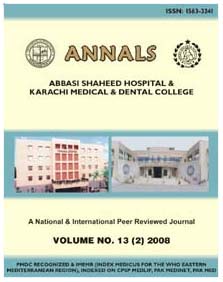| BACTERIOLOGICAL STUDY OF
AEROBIC ISOLATES FROM DIABETIC FOOT INFECTION
Wajid Khurshid Sipra, Muhammad Asif Durani, Saleem Ahmad Kharal,
Fakharuddin, Raziuudin Ahmad
ABSTRACT
Objective
To study the relative frequency of bacterial isolates cultured from
diabetic foot infection and to assess their invitro susceptibility
pattern amongst commonly used antibacterial agents.
Design
It was a retrospective study. Pus samples for bacterial cultures
were collected from 50 patients admitted with diabetic foot ulcers.
All the samples were subjected to conventional bacteriological method.
Antibiotic sensitivity testing was performed according to standard
disk diffusion method of Kirby & Bauer.
Setting
This study was carried out in Department of Microbiology Basic Medical
Science Institutes Jinnah Post Graduates Medical center Karachi
during the period from July to December 2008.
Results
Total 50 cases of diabetic foot ulcer were included in this study.
During the study period 49 cases (98%) revealed positive bacterial
growth while remaining 01(2%) showed no bacterial growth. Out of
which 33 (66%) were Gram –negative and 16 (32%) were Gram-positive
bacteria. Frequently isolated pathogens were Proteus spp 18%, E.coli
14 %, Pseudomonas aeruginosa 14%, Citrobacter spp 8%, Klebseilla
spp 6%, Enterobacter spp 6%, Staphylococcus aureus 24%, Staphylococcus
epidermidis 6% and Staphylococcus saprophyticus 2%. Most bacterial
isolates were sensitive to Cefoxitin, Ciprofloxacin, Aztreonam,
Imipenem, Cefotaxime, Amoxycillin- Clavulanic acid, Vancomycin and
Teicoplanin. Among the Gram-negative bacteria 27.27% were Extended
Spectrum Beta Lactamases (ESBLs) producer while among Gram-positive
bacteria 41.66% were Methicillin Resistant Staphylococcus aureus
(MRSA).
Conclusion
1. The antimicrobial sensitivity pattern of bacterial pathogens
from diabetic foot ulcer clearing the resistance problem and polymicrobial
etiology will help the Clinician for early and appropriate treatment
so that infected Limbs are saved and this shall be more beneficial
for the patient.
2. The commonest isolates were Staphylococcus aureus, Proteus spp,
E.coli and Pseudomonas aeruginosa
Keyword
Gram-positive bacteria, Gram-negative bacteria, Methicillin Resistance
Staphylococcus aureus, Extended Spectrum Beta Lactamases.
.
|

